“Do no harm†to life or car when repairing Nissan LEAF or Altima Hybrid vehicles.
Technological change and rising complexity are constants in collision repair. Whether unibody design, advanced high-strength steels, exotic alloys, or carbon fiber, innovation has ratcheted up the service knowledge, equipment, training, and associated repair techniques required. Today, the electric vehicle (EV) challenge for collision repairers is at hand. Resistance is futile. Preparing, adapting, and training for the inbound change is not.
Nissan’s EV portfolio is growing

The all-electric 2011 Nissan LEAF combines an air-cooled lithium-ion battery pack and a high-response 80kW AC synchronous motor to operate the vehicle’s 440V components.
At Nissan, the electric tide is evidenced by the Altima Hybrid and the all-electric Nissan LEAF – with more models on the way. Even conventional vehicles are incorporating electrified components such as start-stop technology or electric air conditioning. EVs will get into accidents, with many of the subsequent repairs being made at independent collision facilities.
The 2011 LEAF combines an air-cooled, 650-pound, lithium-ion battery pack and high-response 80kW AC synchronous motor to operate the vehicle’s 400V components. LEAF batteries are warranted for 100,000 miles or eight years. At the end of 10 years, Nissan projects that the battery pack will still retain 70 to 80 percent of its capacity.
Nissan says the LEAF has a range of 100 miles in optimal driving conditions. Based on five-cycle tests that employed varying driving conditions and climate controls, the U.S. Environmental Protection Agency says the LEAF averages 73 miles. It found that using the LEAF’s electric air conditioning system, heavy stop-and-go traffic, faster speeds, cold winter temperatures and hilly environments can all reduce range.
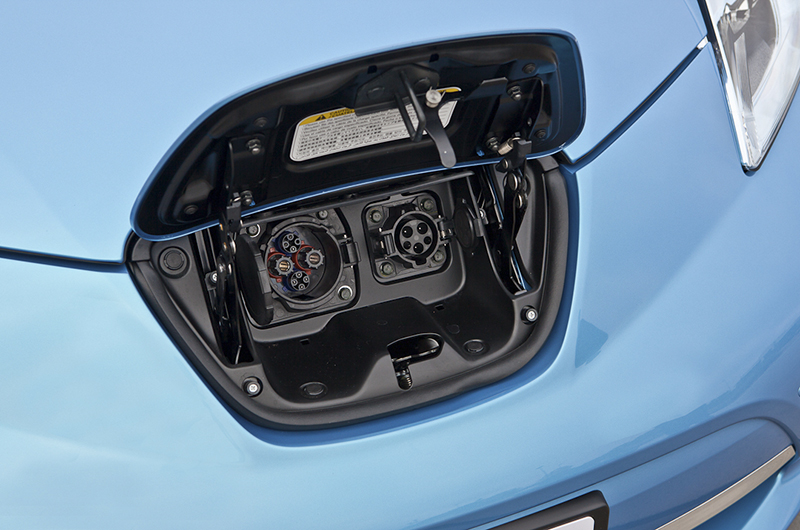
The Leaf 220/240V Level 2 (right) and 440/480V Level 3 (left) charging ports are located under a panel above the front bumper.
The battery pack frame sits underneath the LEAF and helps provide greater body rigidity than a conventional compact car has. The pack consists of 48 laminated modules, each containing four cells, for a total of 192 cells connected in series. Currently, an on-board 3.3-kilowatt battery charger recharges the battery pack. This will be upgraded to 6.6-kilowatts for 2012 for faster recharging, with retrofits available for 2011 models.
Owners have two recharging options. Each uses a SAE J1772 plug, which connects to the driver-side charge port located under a panel at the front of the LEAF. The other end of the cord connects to a power supply. Any standard 110V supply can be used to fully recharge the LEAF in 21 hours (Trickle). Alternately, home-based and public 220/240V (Normal) recharging stations, recommended by Nissan, will do so in seven hours. Should the U.S. adopt emerging 440/480VÂ (Quick) chargers and plugs, the other charge port could be used to recharge the battery pack to 80 percent capacity in just 30 minutes. However, Nissan cautions that Level 3 recharging will cause 10 percent or greater loss in battery capacity over a 10-year period.
In comparison, the Altima Hybrid combines a smaller-sized nickel metal hydride (NiMH) battery pack supplemented by a 2.5L Nissan gasoline engine to power 244V high-voltage technology. The engine employs an Otto-based cycle to deliver higher power density, useful in hilly environments or situations where more range is needed. Unlike the LEAF, no home or public battery recharging is required. Both vehicles, however, have very expensive high-voltage components, including electric A/C compressors, inverters, liquid-cooled DC-DC inverters, electric drive motors, capacitors, air-cooled battery packs, service plugs and wiring that require both awareness and careful handling.

The 2007–2011 Altima Hybrid combines 244V technology and nickel metal hydride battery pack with a 2.5L Nissan internal combustion engine.
Consider this for a moment: A Nissan/Infiniti publication titled Body Shop Administrative Manual for Certified Electric Vehicles (EV) Dealers begins with this statement: “To ensure the safety of body shop personnel, EV battery and high-voltage (HV) parts located near the damaged portion of the vehicles shall be removed and installed by a certified EV dealer. Certified EV dealers have the facilities, equipment and exclusively-trained technicians to safely service your vehicle. The EV should only be delivered to a body shop after removing the battery pack, high-voltage parts and any related parts that may be an obstacle to the body repair and painting process.â€
That’s fine should an Altima Hybrid or LEAF arrive at your collision repair facility from a certified EV dealership, but what if an EV arrives at your facility directly from an accident? Liaison with a Nissan-certified EV dealer is one solution. Becoming EV-ready is another. To do so, key resources such as information, tooling and training must be sourced and aligned to overcome resistance, apprehension and fear.
Nissan/Infiniti service technical information websites are a must-use resource
Service information is a dynamic, evolving database. The LEAF is brand-new and the Altima Hybrid is less than five years old. The Nissan (www.nissan-techinfo.com) and Infiniti (www.infiniti-techinfo.com) service information websites provide collision professionals with access to the most current and accurate Altima Hybrid and LEAF service/repair information, technical service bulletins, schematics, diagrams and useful publications. They should be your primary information source and be consulted before any collision technician ever touches an EV body.
For example, the websites provide year-specific LEAF and Altima Hybrid service manuals, body repair and painting manuals, dismantling guidelines, collision repair warnings, first responder information and more.
Details include:
- When and how to safely remove, store and install high-voltage battery packs.
- Diagrams that show the location of high-voltage components, cutting locations and instructions for the removal of certain high-voltage components for specific collision repair operations.
- Guidelines to safely disconnect the battery pack, then power down high-voltage systems and capacitors, and service plug removal.
- Precautions and procedures for performing welding, painting or other collision repair operations.
- Emergency procedures to follow in the event of a collision or shop accident.
Tech-Mate is the Nissan-approved source for EV tools, equipment and more
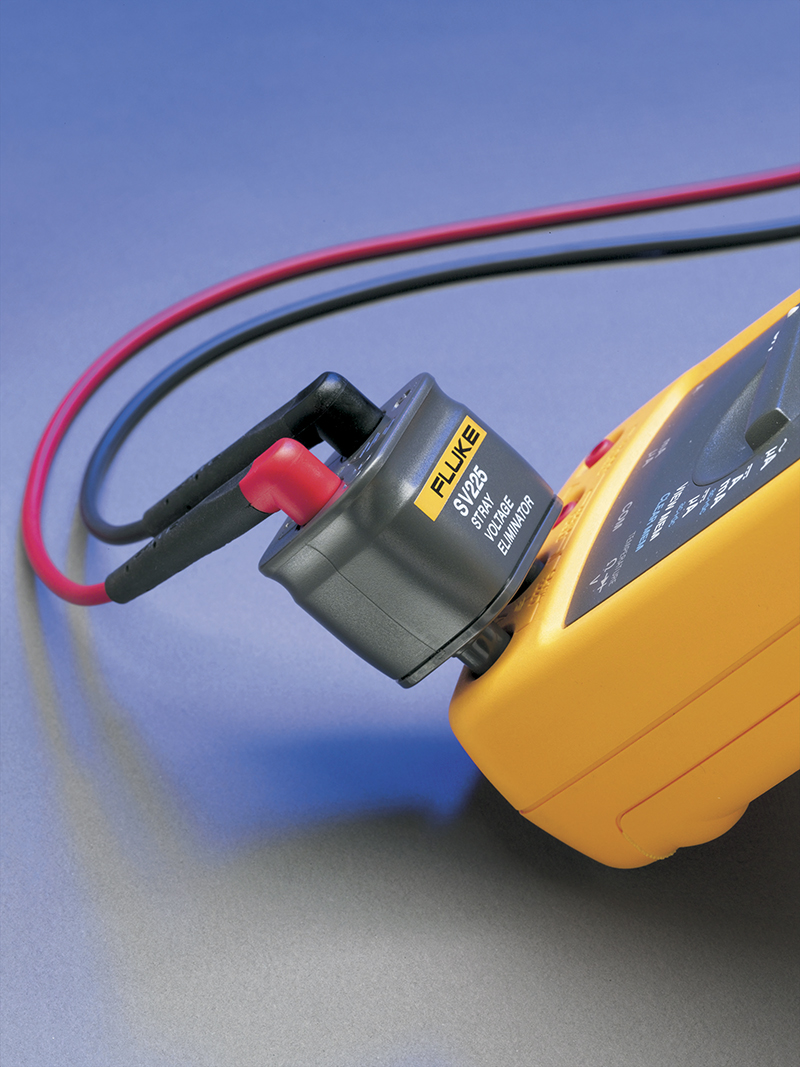
With EVs, just one-tenth of a volt can be the difference between driveability and a no-go. An inexpensive adapter, such as the 225SVE Stray Voltage Eliminator, inserted between an 88V DMM and its leads, can zero-out a multimeter and allow complete repair. (Courtesy Fluke Corp.)
The high-voltage in battery packs, components and wiring can damage and kill. Frying a complex EV-rated multimeter or any of the high-voltage powertrain components can cost you four figures. The cost of cooking an NiMH or Li-ion battery pack in a paint booth, should the temperatures exceed 140°F, exceeds five figures. In addition, the safety of personnel is also critical. Just 40 to 60 volts at 0.50 amps for as little as 20 seconds can kill if it finds a path to the heart. In addition, the high-voltage components and magnetic drive motors can interfere with cardiac pacemakers, defibrillators or other implanted devices inside of personnel. Facilities should check with manufacturers of these medical devices before allowing anyone to work on EVs.
Proper tooling and equipment – from high-voltage safety gloves to battery removal equipment – is critical to preventing damage to expensive EV tools, equipment and vehicle components. To help, Nissan/Infiniti provides a valuable resource to collision facilities: the Tech-Mate Tool and Equipment Program (www.nissantechmate.com). Tech-mate is the only Nissan-approved source for a full range of EV service tools and equipment. Not only are products tested for performance before approval, Tech-Mate specialists will also provide assistance on product selection, application, service and facility planning.
Using the most functional diagnostic scan tool available is essential for the safe, complete collision repair of LEAF or Altima Hybrid vehicles. The Nissan CONSULT-III Plus is the only scan tool available today that can effect and verify complete repairs for both the Nissan LEAF and Altima Hybrid before returning vehicles to customers.
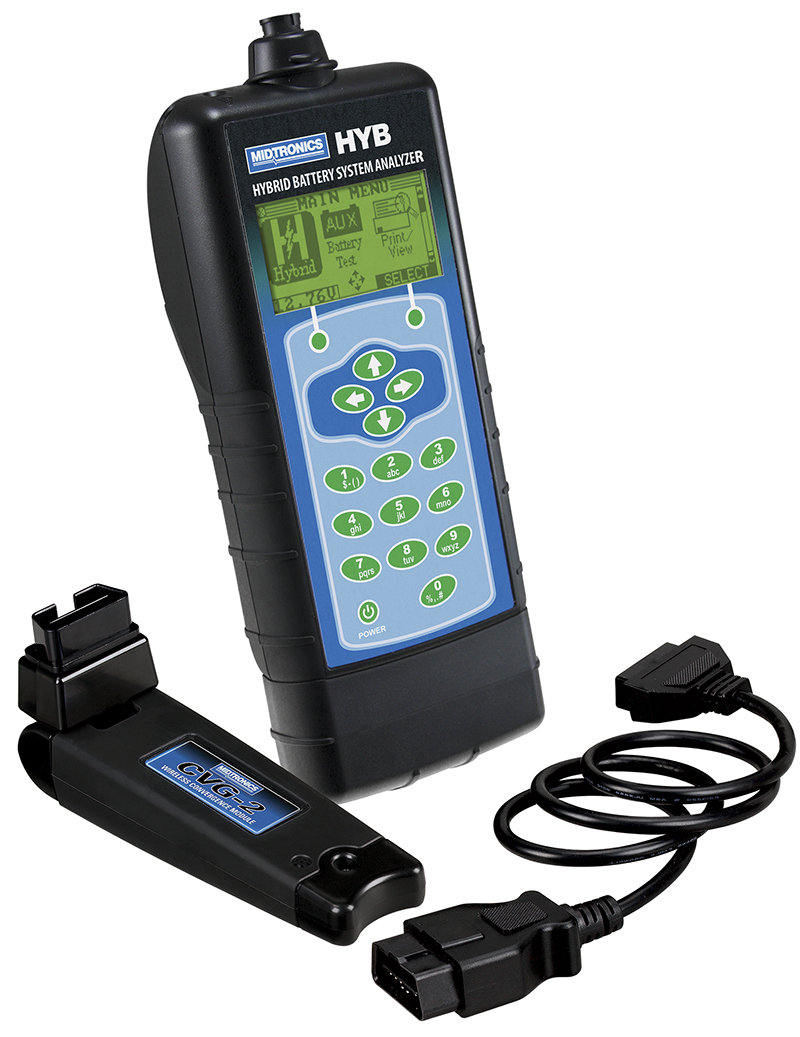
The Midtronics HYB-1000 Hybrid Battery Tester determines if an Altima Hybrid battery pack or some of its individual cells are damaged or underperforming. (Courtesy Midtronics Inc.)
Collision professionals can also consider reputable aftermarket suppliers, such as Fluke Corp. or Midtronics Inc. Here are some examples of what those two companies can provide repair shops and technicians wishing to be fully competent (some of which are available through Tech-Mate):
- DMMs (Digital Multi Meters), such as Fluke’s 88V, differential oscilloscopes, insulated leads and hand tools must be rated at CAT III 1,000V or better. Underrated, defective or damaged DMMs can explode, so technicians should not hold them during use. For eye and face safety, meter readings should always be taken from a side angle.
- As little as 0.10V can be the difference between an EV being driveable and a no-start. Yet many technicians who use a CAT III, 1000V rated multimeter are not aware that these devices and attachments can harbor ghost voltage that exceeds 0.10V. An inexpensive adapter, such as the Fluke’s 225SVE Stray Voltage Eliminator, can zero-out a multimeter to allow accurate diagnosis.
- The Midtronics HYB-1000 Hybrid Battery Tester enables a collision technician to determine if an Altima Hybrid battery pack or some of its individual cells are damaged or underperforming and need replacing, before beginning collision repair.
- Midtronics GRX-5000 EV Module Balancer tool, developed for Nissan, enables repair professionals to check all of a LEAF’s battery pack modules to determine which are defective and need replacement. In addition, similar to the way diesel injectors need to be balanced when one or more is replaced. The new tool will also “pre-condition†new replacement modules to fit the state of the rest of the battery pack.
Seek and maintain EV auto technician certification
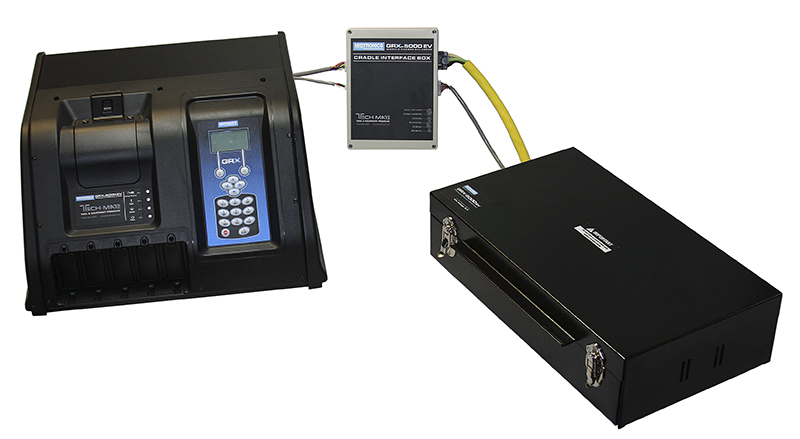
The new GRX-5000 EV Module Balancer determines which, if any, of a LEAF battery pack’s modules are defective, then preconditions new replacement modules to match the state of the battery pack. (Courtesy Midtronics Inc.)
Thorough EV training and continuing education is necessary to harness the service information and hardware to effect collision repair. It’s essential to properly power down, remove, store or install an EV battery pack or other electrified component, as well as to perform any welding, painting or other repair procedure. And remember, it isn’t enough to get current; staying current is also necessary.
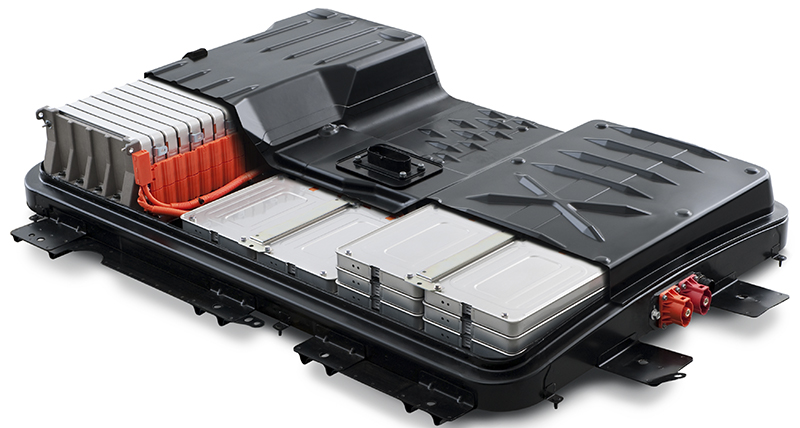
Would you know if and how to safely remove a LEAF or Altima Hybrid battery pack? Nissan/Infiniti service information, Tech-Mate equipment and tools, and approved automaker and aftermarket training are essential.
For example, consider what is involved should the 650-pound battery pack need to be removed from underneath a LEAF. Not only does the pack need to be disconnected from the vehicle first, the remaining components must be disabled and discharged safely. The removal process also requires a special portable platform jack that supports the battery so that it can be lowered just enough to safely and properly remove bolts and disconnect high-voltage wiring cables. Once disconnected, the “live†battery pack must then be lowered and stored safely and securely out of harm’s way, typically on this platform, with caution tape or warning signage.
The Nissan and Infinti websites provide training and education links for this and other collision repair operations for the LEAF and Altima Hybrid. Training is available in three formats – downloadable traditional classroom manuals, e-learning modules, and specialized training videos. Here’s one example of each type:
- Downloadable electronic training includes the LEAF EV Technologies Course, a four-day, classroom-style, instructor-led, competency-based, technical learning experience. It provides a detailed look at the systems, operation, and safety procedures for the LEAF.
- Video training includes Volume 162: CONSULT-III Plus, and Volume 156: Replacing the Altima Hybrid Battery, which looks at the procedures for replacing the high-voltage (HV) battery. It covers a battery system overview, the training required, necessary safety    precautions, and the procedures for disassembling and removing the HV battery and the individual components of its subassembly.
- E-Module training includes the Introduction toEV Technologies and Introduction to EV Safetyand Overview. Both are available to any person holding a valid Nissan/Infiniti website subscription.
Today, over three million hybrids have been sold worldwide, two million of them here in the America. More partial or full EVs are coming, as they help automakers meet tougher fuel economy and emission regulations. That commitment is going to impact your business. Don’t let the opportunity to perform EV collision repairs pass you by.

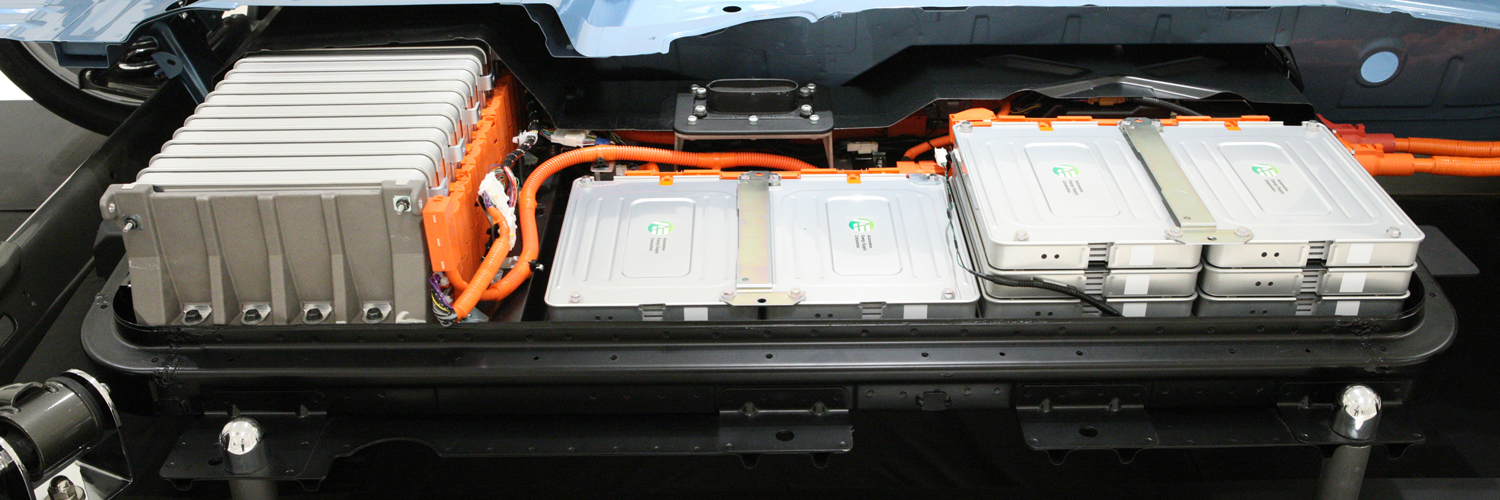




0 Comments